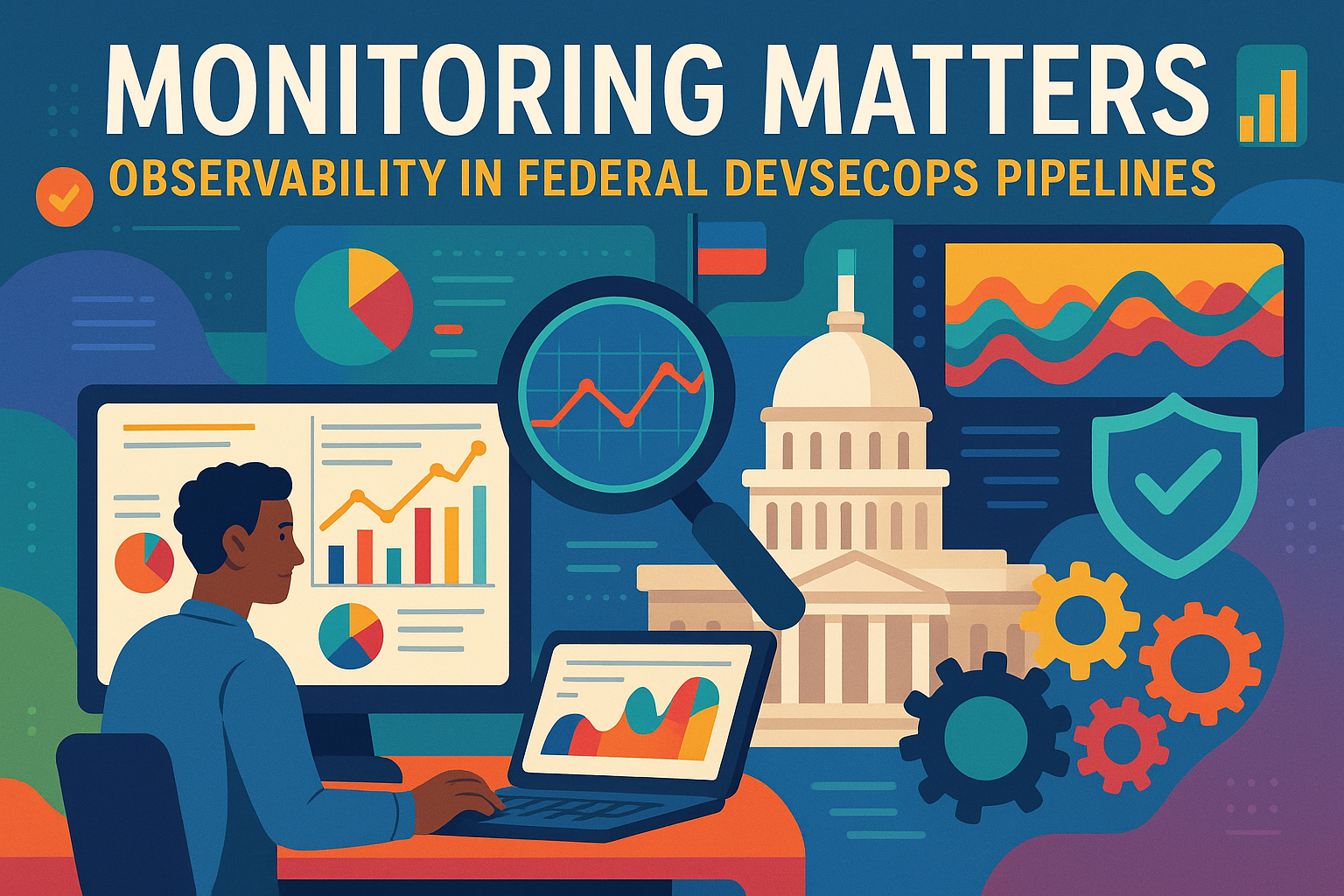Monitoring Matters: Observability in Federal DevSecOps Pipelines
In today’s sprawling, high-stakes federal DevSecOps environments, relying on traditional monitoring is like bringing a flip phone to a cybersecurity knife fight—only intelligent, proactive observability can keep the mission from crashing and burning.

Federal agencies are drowning in data while simultaneously flying blind through their IT infrastructures. It's like having a mansion with no light switches - you know there's valuable stuff in there, but good luck finding it when something goes wrong. Modern federal DevSecOps environments require sophisticated observability solutions that go far beyond traditional monitoring approaches, providing the deep insights necessary to maintain mission-critical systems while meeting stringent compliance requirements.
The Federal Observability Predicament: Welcome to the Jungle
Let's be honest here. Federal IT environments aren't your typical startup's three-server setup running in someone's garage.
We're talking about massive, distributed, multi-cloud, hybrid infrastructures that would make a NASA engineer weep. The Department of Defense alone manages systems that span from legacy mainframes older than some of the people reading this to cutting-edge containerized microservices that update faster than TikTok trends.
And here's the kicker - everything needs to be secure, compliant, and available 24/7. No pressure, right?
The Biden administration's IT Modernization and Zero Trust mandates have basically said "Hey federal agencies, transform your entire IT infrastructure while maintaining perfect security and never going down." It's like being asked to rebuild a plane while flying it. In a hurricane. With one hand tied behind your back.
But wait, there's more! Federal networks are more dynamic than ever before. Multi-cloud workloads? Check. Microservices? Double check. Edge deployments that make your head spin? Triple check with a cherry on top.
This complexity creates what we in the business like to call "blind spots." And blind spots in federal environments aren't just inconvenient - they're potentially catastrophic.
Traditional Monitoring: The Equivalent of Using a Flip Phone in 2025
Remember when monitoring meant checking if a server was up or down? Those were simpler times. Like when we thought Y2K was going to end civilization.
Traditional monitoring tools are like that friend who only texts you when something's already gone horribly wrong. "Hey, your database crashed three hours ago. Thought you should know!" Thanks, Karen. Super helpful.
Federal agencies need to move from basic monitoring to what the cool kids call "intelligent, proactive observability." It's the difference between knowing your car broke down versus understanding that your engine temperature has been slowly rising for the past 50 miles because your cooling system has a microscopic leak.
The problem with traditional approaches? They're reactive. They tell you what happened after your users are already calling the help desk. Or worse, after the mission fails.
In federal environments, reactive monitoring is like having a security guard who only shows up after the bank robbery. Technically they're doing their job, but the timing could use some work.
Open Source Heroes: Prometheus, Grafana, and the Gang
Enter the open source cavalry! Prometheus, Grafana, Loki - these tools sound like characters from a Marvel movie, and honestly, they're probably just as powerful.
Prometheus has become the de facto standard for metrics-based monitoring. It's like the Swiss Army knife of the monitoring world - versatile, reliable, and trusted by pretty much everyone who's ever deployed a container.
Grafana makes beautiful dashboards that would make a data visualization artist cry tears of joy. Seriously, have you seen some of these dashboards? They're like stained glass windows for IT data.
Loki handles log aggregation like a boss. It's basically Prometheus for logs, which is either really clever naming or someone in the development team has a serious mythology obsession.
But here's where things get interesting (and by interesting, I mean complicated).
Where Open Source Gets... Complicated
Scaling Prometheus is like trying to organize a family reunion - it starts simple but quickly becomes a logistical nightmare that requires extensive planning, multiple moving parts, and inevitable compromises.
When you start small, Prometheus is great. One instance, scraping your services, everything's beautiful. But then your infrastructure grows. And grows. And suddenly you need multiple Prometheus instances because your data won't fit in one anymore.
Now you're sharding data across instances. Do you shard by service? By instance? By the phase of the moon? These decisions matter, and getting them wrong means your developers spend more time figuring out which Prometheus instance has their data than actually fixing problems.
Speaking of developers - imagine having to remember which of your 47 Prometheus instances contains the metrics you need for debugging. It's like having a library where all the books are randomly distributed across different buildings in different cities.
And don't get me started on high availability. Running Prometheus on a single node is basically playing Russian roulette with your monitoring infrastructure. You need redundancy, but redundant Prometheus instances can give you inconsistent results. Nothing says "professional monitoring setup" like having two different answers to the same question.
Long-term storage? Prometheus wasn't designed for that. It's like using a sports car to move furniture - technically possible, but you're definitely using the wrong tool for the job.
Most organizations end up storing only a week or two of data in Prometheus. Try explaining to your federal audit team why you can't provide historical trend analysis for the past quarter because your monitoring tool wasn't designed for long-term retention.
Federal Complexity: Because Regular Complexity Wasn't Hard Enough
Federal environments add their own special flavor of complexity. It's like regular IT complexity, but with extra paperwork and the constant awareness that if something goes wrong, it might end up on the evening news.
FedRAMP authorization? Required. FIPS 140-2 compliance? Non-negotiable. Department of Defense Information Network Approved Product List (DoDIN APL) certification? Better have it.
The DoD DevSecOps Fundamentals document makes it clear that continuous monitoring isn't just nice to have - it's mandatory for maintaining a continuous Authority to Operate (cATO).
Without proper observability, you're basically telling your Authorizing Official "Trust us, everything's fine" while crossing your fingers behind your back.
Federal agencies need solutions that can handle Common Criteria evaluations, Federal Information Processing Standards, and security assessments that would make a paranoid android nervous.
And let's talk about the elephant in the room - compliance reporting. Your typical open source monitoring setup doesn't exactly come with pre-built reports for FISMA compliance or DoD RMF requirements. Hope you like creating custom dashboards!
The Integration Nightmare: When Tools Don't Play Nice
Here's a fun fact: federal agencies typically use anywhere from 10 to 50 different monitoring and security tools. Getting these tools to work together is like trying to conduct an orchestra where half the musicians are playing different songs and the other half are using instruments from different centuries.
You've got your network monitoring tools, your application performance monitoring, your security information and event management (SIEM) systems, your log aggregation platforms, and about 47 other acronyms that all claim to provide "comprehensive visibility."
The result? Tool sprawl that would make a hardware store jealous and alert fatigue that has your operations team developing selective hearing.
Correlation across these disparate tools requires either a PhD in data science or enough coffee to power a small city. Usually both.
The Cognitive Load Problem: When Smart People Can't Think Straight
Let's talk about something the vendor presentations never mention - cognitive load.
Your brilliant federal IT professionals are spending an increasing amount of their brain power just remembering which tool contains which data. It's like being a librarian in a library where every book is in a different room, in a different building, with a different filing system.
When you're trying to debug a cross-service issue at 3 AM, the last thing you want is to play twenty questions with your monitoring infrastructure. "Is this metric in Prometheus instance 12 or 13? Was that log event captured by Loki cluster A or B? Why is everything broken and why did I choose this career?"
The cognitive overhead of managing multiple monitoring tools in a complex federal environment isn't just inefficient - it's dangerous. When people are stressed and under pressure, they make mistakes. In federal environments, mistakes can have consequences that extend far beyond a simple service outage.
Enter the Commercial Cavalry: When You Need the Big Guns
This is where commercial solutions like Dynatrace enter the picture, wearing a cape and carrying FedRAMP authorization papers.
Dynatrace for federal environments isn't just another monitoring tool - it's like having a monitoring Swiss Army knife that also happens to be certified for government use. FedRAMP authorized? Check. FIPS 140-2 compliant? Check. Multiple DoD/IC ATOs? Check and check.
But here's what really matters - it's designed to handle the complexity that makes federal IT professionals question their life choices.
Full-stack observability from a single platform? That's like having one remote control that actually works with all your devices. Revolutionary stuff.
AI-powered insights that can actually tell you why something broke, not just that it broke? It's like having a monitoring system with a built-in IT psychic.
Automatic discovery and dependency mapping? Finally, someone who understands that manually documenting every service dependency in a microservices environment is like trying to count grains of sand during a windstorm.
The Economics of Sanity: ROI vs. Hair Loss
Let's do some math that doesn't involve calculus or crying.
Managing multiple open source monitoring tools requires dedicated staff. Not just one person - we're talking about a team. Database administrators for your metrics storage, systems administrators for your monitoring infrastructure, developers to build custom integrations, and someone whose full-time job is just figuring out why the alerts from different systems are contradicting each other.
Compare that to a unified platform where most of the integration work is already done, the scaling challenges have been solved by people who get paid to think about scaling challenges all day, and the compliance certifications are maintained by teams of people whose job title probably includes words like "certification" and "compliance."
The time-to-value difference is like comparing a microwave dinner to growing your own vegetables. Sure, you could plant a garden, tend it for months, harvest the vegetables, and cook from scratch. Or you could have dinner ready in three minutes.
For federal agencies with mission-critical deadlines and limited IT staff, sometimes the microwave dinner is the right choice.
Real-World Reality Check: The Implementation Blues
Here's what nobody tells you about implementing observability in federal environments: it's not just about the technology.
You need to navigate procurement processes that move slower than continental drift. You need to coordinate with security teams who view any new technology with the suspicion typically reserved for used car salesmen. You need to train staff on new tools while maintaining existing systems that cannot, under any circumstances, go down.
And you need to do all of this while demonstrating clear ROI to stakeholders who want to see immediate results from investments that typically take months to fully implement.
Open source solutions require internal expertise development. Commercial solutions require budget approvals. Both require patience, planning, and probably more meetings than any human should have to attend.
But here's the thing - the status quo isn't working. Federal agencies can't continue to manage increasingly complex infrastructures with monitoring approaches designed for simpler times.
The Future is Observability (Whether We Like It or Not)
The writing is on the wall, and it's written in metrics, logs, and traces.
Federal agencies are modernizing whether they want to or not. Cloud adoption isn't slowing down. Microservices architectures aren't going away. DevSecOps isn't just a buzzword anymore - it's becoming operational reality.
This means observability isn't optional. It's like saying "breathing is optional" - technically true, but not recommended for long-term success.
The question isn't whether federal agencies need better observability. The question is how they're going to achieve it.
Some will choose the open source route, building custom solutions with internal teams and accepting the complexity that comes with that approach. Others will choose commercial platforms that handle much of the complexity behind the scenes.
Both approaches can work. Both have tradeoffs. The key is making an informed decision based on actual requirements rather than vendor marketing or open source ideology.
The Bottom Line: Monitor Like Your Mission Depends on It
Because it probably does.
Federal IT isn't just about keeping systems running - it's about enabling missions that matter. Whether that's delivering services to citizens, supporting military operations, or advancing scientific research, the underlying IT infrastructure is what makes it all possible.
Poor observability means poor reliability. Poor reliability means mission impact. Mission impact in federal environments can have consequences that extend far beyond IT operations.
So yes, monitoring matters. Observability matters more. The question is whether you're going to build it, buy it, or continue hoping that your current monitoring setup will somehow become adequate through wishful thinking alone.
Spoiler alert: wishful thinking has a poor track record in IT operations.
The good news? There are solutions available. Both open source and commercial options exist that can provide the level of observability federal environments require. The better news? You don't have to figure it all out alone.
Whether you choose Prometheus and friends or Dynatrace and their federal-friendly credentials, the important thing is choosing something. Because the alternative - flying blind through increasingly complex federal IT environments - isn't really an alternative at all.
It's just a really expensive way to learn about chaos theory.
Conclusion: The Monitoring Revolution Will Be Digitized
Federal DevSecOps environments represent some of the most complex IT challenges on the planet. Traditional monitoring approaches simply aren't sufficient for managing this complexity while meeting federal requirements for security, compliance, and reliability.
Open source tools like Prometheus, Grafana, and Loki offer powerful capabilities but require significant expertise and ongoing management overhead. Commercial solutions like Dynatrace provide unified platforms with federal certifications but require different investment considerations.
The choice between open source and commercial observability solutions isn't about right or wrong - it's about matching capabilities to requirements, resources to constraints, and solutions to organizational contexts. What matters most is making an informed decision and implementing observability practices that support mission success rather than creating additional operational burden.
Because at the end of the day, federal IT professionals have enough challenges without their monitoring infrastructure being one of them. They deserve tools that work, insights that matter, and solutions that scale with their mission requirements.
The future of federal DevSecOps is observable, automated, and intelligent. The only question is how quickly we can get there.

